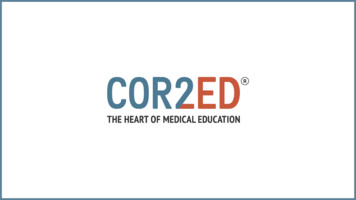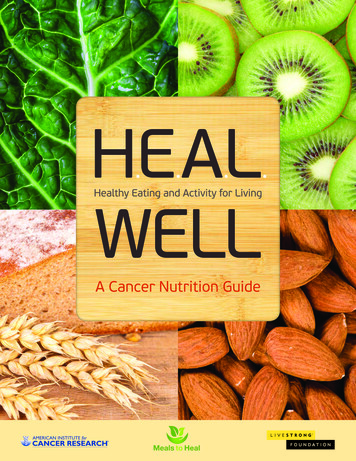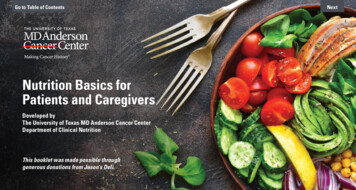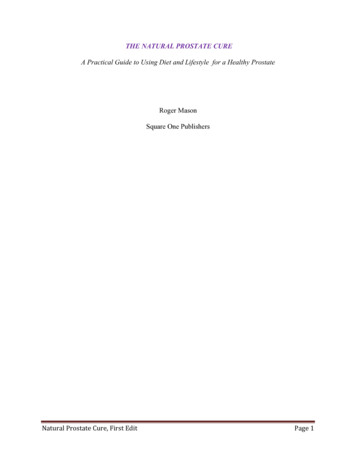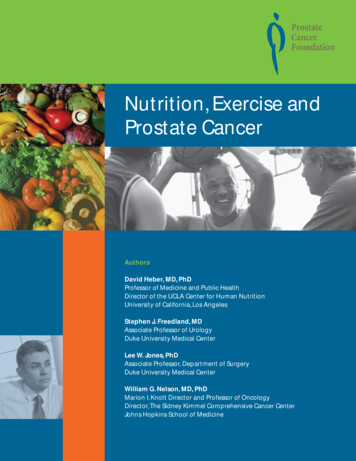
Transcription
Nutrition, Exercise andProstate CancerAuthorsDavid Heber, MD, PhDProfessor of Medicine and Public HealthDirector of the UCLA Center for Human NutritionUniversity of California, Los AngelesStephen J. Freedland, MDAssociate Professor of UrologyDuke University Medical CenterLee W. Jones, PhDAssociate Professor, Department of SurgeryDuke University Medical CenterWilliam G. Nelson, MD, PhDMarion I. Knott Director and Professor of OncologyDirector, The Sidney Kimmel Comprehensive Cancer CenterJohns Hopkins School of Medicine
The Prostate Cancer Foundation (PCF) was founded in 1993 to find bettertreatments and a cure for recurrent prostate cancer. Through its uniquemodel for soliciting and selecting promising research programs and rapiddeployment of resources, the PCF has funded more than 1,500 programsat nearly 200 research centers in 20 countries around the world.As the world’s leading philanthropic organization for funding prostate-cancerresearch, the PCF is now a foundation without borders. Its advocacy forincreased government and private support of prostate cancer programshas helped build a global research enterprise of nearly 10 billion.Today, 40 percent fewer men are dying from prostate cancer comparedfor moreto what was once projected. The PCF is a force ofthan 16 million men and their families around the world who are currentlyfacing the disease.HOPEStudies have shown that lifestyle — especially nutrition and exercise — hasa significant influence in prostate cancer prevention and treatment. This guidepresents the latest information for men who want to maintain a lifestyle thatpromotes prostate health.
Table of uction3Understanding the Links BetweenNutrition, Exercise, and Prostate CancerEffects of Oxidation and InflammationThe Contribution of CarcinogensEffects of Excess SugarPutting It All Together34568991011121215151618181920202023Obesity and Metabolism — Where WeWent WrongThe Metabolic SyndromeEffects of Excess Body FatEffects of Muscle LossNutrition at the Molecular LevelThe Contribution of Antioxidants andPhytochemicalsThe Color System of AntioxidantsThe Delicate Balancing Act ofSupplement UseAvoiding Toxicity and OverdosingMaking the Smart ChoiceImplementing a Plan for SuccessBuilding Strong MusclesRestoring a Healthful Caloric BalanceIncorporating Good Nutrition andExercise Into Your Everyday RoutineReviewing the Benefits Stage by StageAdopting a Healthy Approach23A Commitment to ChangeThe Decision to Change25The Four S’s of Success27Suggested Reading
Nutrition, Exercise and Prostate CancerIntroductionTreatment options for prostate cancer aremore effective than ever before. Yet, formany men, the diagnosis and treatmentof cancer brings to their attention the need tochange their diet and exercise behaviors. Whilethe primary focus of the prostate cancer survivoris to live a life free of cancer, more men arebeginning to realize that a healthy diet andregular exercise can be an important step towardpreventing other diseases that commonly occurwith aging, including heart disease and diabetes.Exciting new data suggest that this same approachmay also slow prostate cancer growth. Thisguide takes the best published evidence frompopulation studies, basic science, and limitedhuman studies, and puts them together in waysthat make practical sense — with the overall goalof helping you achieve “thrivership” not justsurvivorship.What is thrivership? The Merriam-Websterdictionary defines thriver as one who progressestoward a goal despite circumstances, and flourishes.The diagnosis of prostate cancer can lead you inone of two directions. Some will react to thisdiagnosis with a sense of resignation and fatalism.This view can lead to helplessness — waiting for theother shoe of cancer recurrence or progression todrop. On the other hand, thrivership puts you in the2driver’s seat — making you as vital to your care andtreatment as any doctor or nurse. You may have hadprostate cancer, but now you are in charge of yourlife, adopting new healthy habits and enjoying eachday to its fullest. As a prostate cancer thriver, you canuse the latest knowledge about nutrition andexercise to improve your overall health and qualityof life. Your diagnosis of prostate cancer can be thebeginning of a healthier lifestyle.As a prostate cancer thriver, you can usethe latest knowledge about nutrition andexercise to improve your overall healthand quality of lifeA working group of the leading experts andscholars in nutrition, exercise, and prostate cancerwere gathered from across the United States andasked to provide their advice to us in developingthis guide. It is our hope that you will benefit fromthe recommendations in this guide for a healthydiet and regular exercise, and that you will achievea better understanding of the roles of diet andexercise in the prevention of age-related diseases,as well as in the recurrence and progression ofprostate cancer.
Nutrition, Exercise and Prostate CancerUnderstanding the Links Between Nutrition,Exercise, and Prostate CancerOur modern society is characterized by alifestyle with low levels of exercise coupledwith consumption of foods that are highin calories, fat, sugar, and salt. But your body stillresponds in the only way it knows — it stores excessfood as fat to prepare for times of prolongedstarvation. Of course, because prolonged starvationtypically does not happen in modern society, thissafety mechanism means that we just continue togain weight and store more fat.This excess fat, especially the fat around the middleof your body, has been associated with an increasedrisk of many diseases, including prostate cancer,and particularly aggressive prostate cancer. But youdon’t have to be 50 pounds overweight to suffer theill effects of excess body fat. Body fat is actuallyan organ with functions. It secretes hormones andspecialized proteins that can increase inflammationand oxidation in the cells of your body — twonatural processes that are strong contributors to thedevelopment and progression of prostate cancer.Effects of Oxidation and InflammationOxygen is essential to life, but the chemistry ofoxygen and oxidation drives cancer development.Oxidation is a normal chemical reaction that occurswhen free radicals form within the cells of theprostate. Each oxygen atom contains two electronsthat cling together. When heat or light breaks apartthe atom, the electrons are separated, leavingunpaired oxygen radicals. These radicals are free toroam around and initiate a process of breakingdown normal cellular structures, causing damageand promoting the development of cancer.The more free radicals present, the more cancercausing damage occurs.This process is similar to what happens during thebrowning of an apple after it is sliced open and theflesh of the apple is exposed to the oxygen in theair. The oxygen atoms in the air interact with thesugar in the apple, forming oxygen radicals. Theseradicals break down the flesh of the apple, oroxidize it, and the apple begins to rot.As long as the outer peel of the apple protectsthe inner flesh from oxygen, it is not oxidized.But when protective “antioxidants” are removed,the damage from oxidation is allowed to occurunimpeded. Likewise, our bodies have manysophisticated defenses against oxidation. Butwhen these defenses break down, cancerous cellsform and are allowed to grow.One of the most common causes of the lossof protective antioxidants is inflammation, abiochemical process that your body initiateswhen fighting off an infection. If the body sensesinvaders, such as bacteria, white blood cells aremobilized to go to the site of the invasion and torelease oxygen and nitrogen radicals to help kill theinvaders. Unfortunately, if they remain unchecked,these same oxygen radicals can also break downnormal tissue and promote the development ofcancer. Oxygen radicals damage normal DNA,causing errors that allow cancer growth.In fact, investigators have noted the presence ofinflammatory cells in virtually all prostate cancer3
Nutrition, Exercise and Prostate Cancertissue that is removed surgically, and have found thatinflammation leads to the atrophy, or wasting away,of normal prostate tissue adjacent to precancerousand cancerous areas of prostate tissue.Based on these and other observations, evidence ismounting that inflammation and oxidation playkey roles in the development of prostate cancer.Why is this important? Because although othercontributory factors such as aging and alteredhormone secretions are difficult or impossible tochange, nutritional and exercise habits that reducethe development of inflammation and oxidationcan be changed.Although some factors that contribute to prostatecancer are difficult or impossible to change,nutritional and exercise habits that reduceinflammation and oxidation can be changedand vegetables, herbs, and spices can all actagainst both oxidation and inflammation.Finally, recent research has suggested that regularexercise may be one of the best natural antioxidants.Regular exercise causes many changes in your bodythat help reduce circulating levels of reactive oxygeninflammation. Beyond burning calories, endurancetype exercises, such as walking, running, cycling, andswimming, are particularly effective at increasing thebody’s natural levels of antioxidants, eliminatinginflammatory molecules that drive cancer.Endurance-type exercises, such as walking,running, cycling, and swimming, areparticularly effective at increasing thebody’s natural levels of antioxidantsThe Contribution of CarcinogensThere are many anti-inflammatory and antioxidantsubstances found in colorful fruits and vegetables,whole grains, and spices — nearly all of which areabsent from the processed foods that rely on sugar,salt, and fat for flavor. By focusing your diet onfresh fruits and vegetables, ocean-caught fish, andwhole grains, you can increase the protective antiinflammatory components of your diet and beginto benefit from their effects.For example, tomato-based products such assoups, pasta, and juices can increase levels ofthe antioxidant lycopene in the prostate gland.Drinking beverages such as pomegranate juiceand green and black tea can increase levelsof antioxidant-containing polyphenols. Thecruciferous vegetables such as broccoli,Brussels sprouts, bok choy, wasabi mustard,and horseradish all contain substances thatmay induce protective proteins in your liver andtissues, while vitamins, minerals, extracts of fruits4Inflammation and oxidation are two of the body’snatural processes, which, when they are allowed toproceed unchecked, can influence the developmentof prostate cancer. But external substances also playan important role — and can also be thwarted bykeeping to a healthy diet.A carcinogen is a chemical that directly or indirectlycauses or leads to more aggressive forms of cancer.Hundreds of chemicals have been definitively linkedto cellular changes that lead to cancer development,and hundreds more have been implicated inprocesses that might be involved. In today’sindustrial society, it’s hard to avoid all exposure tocarcinogens. But by focusing on a healthy diet andon healthy eating practices, you can avoid increasingyour exposure to carcinogens that contribute tothe development of prostate cancer.For example, overcooking of any type of meatat very high temperatures produces a set of
Nutrition, Exercise and Prostate Cancercarcinogens called heterocyclic amines, one ofwhich, known as PhIP, has been shown to causeprostate cancer in animal studies. In addition,charbroiling red meat or chicken, with its skinintact, produces yet another set of carcinogens,called polycyclic aromatic hydrocarbons.The deleterious effects of these two carcinogensare well known — when tobacco leaves are burnedin cigarettes, heterocyclic amines and polycyclicaromatic hydrocarbons are produced and inhaled,playing a role in the development of lung cancer.Remarkably, by eating overcooked and charbroiledmeats, the average American consumes the sameamount of carcinogens (as PhlPs) as are inhaled in apack-and-a-half of cigarettes a day.Laboratory research findings have suggestedthat intake of these charred meat carcinogenstriggers mutations in prostate cell DNA andleads to a chronic inflammatory response in theprostate. This combination of mutations andinflammation appear to be a key to thedevelopment of prostate cancer.charbroiling meats. Also, using alternate methods tocook meat can significantly cut down on theamount of carcinogens produced: choose steamingor baking over charbroiling or pan-frying, marinatethe meat, and turn the meat frequently to preventovercooking. Finally, increase your consumptionof cruciferous vegetables, which have uniqueproperties that enable them to help “sponge up”carcinogens and possibly even counteract some ofthe damage caused by these carcinogens.Effects of Excess SugarOver the last 20 years, as intake of sugarsfrom processed foods has gone up, obesity rateshave skyrocketed, leading many researchers toimplicate excess sugar in the current obesityepidemic. In fact, recent work suggests that highfructose corn syrup — a form of sugar frequentlyfound in processed foods such as soft drinks —is converted to fat much more quickly than isnaturally occurring glucose.PhIP (depicted in yellow and dark blue) has the same DNAmutational capacity as cigarette smoke but the carcinogenaccumulates only in the prostate. This finding has triggeredmajor new studies on the healthiest way to cook meats inorder to protect the prostate from accumulatingcarcinogens over a lifetime.Yet, the negative effects of excess sugarbegin even before it is stored as fat. Sugar isa prime energy source for many cancers,including prostate cancer. Most normal cellscan adapt to an environment low in sugar anduse other energy sources — a processdeveloped through evolution when peoplewould go through periods of starvation. However,cancer, which grows faster than normal cells,does not have the same ability to adapt to lowsugar environments. Thus, the more excesssugar consumed, the more the tumor is stimulated.Indeed, several animal studiessuggest that cutting simple sugar intake canslow prostate cancer growth.Switching to alternate sources of protein thatare not prone to forming carcinogens when cooked,such as soy, is an important first step in minimizingthe damage caused by overcooking andExcess sugar intake is further linked toprostate cancer growth through its interactionswith insulin. Upon consumption of sugar, the bodyproduces insulin, which helps to break down the5
Nutrition, Exercise and Prostate Cancersugar, ensuring that the sugar is stored as needed.When too much sugar is consumed and the bodyconstantly produces high levels of insulin to helpprocess it, the cells can become immune to theeffects of insulin, resulting in too-high levels ofsugar in the blood — a common sign of metabolicsyndrome and a strong risk factor for diabetes. Inaddition, high insulin levels have been linked toan increased risk of diabetes, heart disease, andprostate cancer growth, independent of itsinteraction with sugar.Putting this evidence together, research is beginningto suggest that the more processed sugars you eat,the higher your insulin levels, and the more likely it isthat your prostate cancer will grow.Research is beginning to suggest that themore simple sugars you eat, the higher yourinsulin levels, and the more likely it is thatyour prostate cancer will growYet, cutting back on sugar intake is only oneimportant step. Studies of animals with prostatecancer have shown that restricting overall caloricintake can slow advancement of their disease.Maintaining a healthy diet and engaging in aregular exercise regimen will not only help youachieve and maintain your goal weight, it mightalso help slow the growth of cancer. Workingwith a qualified nutritional counselor will help6you identify “good” and “bad” foods, while workingwith a qualified exercise physiologistwill help you develop an exercise regimen tokeep you fit.Putting It All TogetherThe modern diet and sedentary lifestyle can leadto an accumulation of body fat, which, in turn, cancontribute to the development of inflammationand raise insulin levels. At the same time, a highcalorie, high-sugar, pro-inflammatory diet canpromote age-related chronic diseases and mayprove an important link between nutrition andprostate cancer development and progression.Even modest changes in body fat compositionthrough changes in diet choices and regularexercise can be beneficial — a 5% weight loss hasbeen shown to decrease markers of inflammationby 30% in obese diabetic patients and to reduceinsulin levels by 20% in non-diabetic people.While excess weight has been associated withmore severe and rapidly progressive prostatecancer, up to 60% of men at normal body weightand with an average-sized waist carry excessbody fat around their abdomens. Focusing ona diet that is rich in antioxidants, low in proinflammatory and carcinogenic substances, andlow in simple sugars — coupled with a regularexercise regimen — can make an importantdifference in improving the overall health ofevery prostate cancer thriver.
Nutrition, Exercise and Prostate CancerKey Points to Remember1Oxidation and inflammation play important roles in the development of prostate cancer2Anti-inflammatory and antioxidant substances found in colorful fruits and vegetables cancounteract the damage caused by oxidation and inflammation3Carcinogens from charred meat can trigger chronic inflammation in the prostate4Using alternate methods to cook meat and increasing cruciferous vegetables can minimize intakeof and damage from carcinogens5Sugar is a primary energy source for cancer and stimulates production of insulin, which is linked toan increased risk of diabetes, heart disease, and prostate cancer6Cutting back on sugar intake, maintaining a healthy diet, and engaging in a regular exerciseregimen can help slow the growth of cancer7
Nutrition, Exercise and Prostate CancerObesity and Metabolism — Where We Went WrongThe human genome dates back morethan 50,000 years, to a time when manwas a “hunter-gatherer,” consumed a dietconsisting of about 90% plant-derived foods, andengaged in constant physical activity to survive. Inthe modern, post-industrial era, our level of physicalactivity is dramatically reduced and our diet hasincreasingly shifted toward a meat-based diet: theaverage adult in the United States consumes closeto 200 pounds of meat, poultry, and fish per year,an increase of 50 pounds per person from 50 yearsago. Compared with plant-based protein sources,animal-based protein sources are higher insaturated fat, lower in fiber, and poorer inmicronutrients, especially antioxidants.More than 50% of adults in the United States donot eat a single piece of fruit per day and morethan 80% do not meet the recommended intakeof five servings of fruits and vegetables per day. Infact, if one eliminates potatoes (and French fries),the average American eats fewer than two servingsof fruits and vegetables per day. At the same time,only about 20% of American adults meet theminimum exercise guidelines of at least 30 minutesper day, three times per week.More than 80% of adults do not eat therecommended five servings of fruits andvegetables per day; eliminating potatoes(and French fries), the average Americaneats fewer than two servings of fruits andvegetables per day8The modern Western diet has virtually eliminatedmalnutrition in the majority of the population.However, many of the food choices for individualsof limited means, or for those uneducated in therelationship between food and health, are of poornutritional value and are lacking key vitaminsand minerals. In fact, the least expensive foodsavailable today provide fewer nutrients per caloriethan do the more expensive foods.Thus, in the process of solving the problem ofmalnutrition through industrialization, we’vecreated a low-cost food supply that promotesa global epidemic of obesity. In addition, thelargely sedentary lifestyle indicative of an“advanced” society effectively means that wenow have to pay for exercise — with money,time, or both — because exercise in the formof hard physical work, as part of daily living,is scarce.Multiple studies in the past decade have shownan increased incidence of obesity, chronic diseasesof aging, heart disease, and cancer in populationseating a Western diet and having a sedentarylifestyle, versus populations that are physicallyactive and eat fewer calories, less refinedcarbohydrates, less meat, and more fruits,vegetables, cereals, and whole grains. Tounderstand why this lifestyle shift would have sucha profound effect on human health, investigatorshave begun to look more closely at the true effectsof the metabolic syndrome and its co-conspirators,excess body fat and muscle loss, on the humanbody.
Nutrition, Exercise and Prostate CancerThe Metabolic SyndromeFor many years, doctors noticed that overweightor obese patients often had the following commondiseases — high blood pressure or hypertension,increased blood sugar or diabetes, and high levelsof blood fats, specifically triglycerides. In addition,these patients were at greater risk of developinginsulin resistance and type 2 diabetes.Because these different conditions are so common,their coexistence seemed to be asimple coincidence — after all, common diseasesoccur commonly. However, in the last two decades,the coexistence of these conditions, collectivelyknown as metabolic syndrome, has been found tohave a very specific underlying cause — increasedabdominal fat and insulin resistance.Metabolic syndrome affects up to 50% ofAmericans between the ages of 45 and 65.Since an estimated 65% of adults in the US areoverweight or obese, it is not surprising thatmetabolic syndrome and the detrimentaleffects of its component chronic diseases isso common.Effects of Excess Body FatObesity is the result of an imbalance of food intakeand exercise. When you eat more and exercise less,fat accumulates in the body. The first place that fataccumulates in men is in the middle of the bodyaround the belly and abdomen.Belly fat is specially evolved to store fat quicklyand release it quickly. Thus, this is the first placethe fat settles when you gain weight and the firstplace it leaves when you lose weight. Since this fatgrows so quickly, it can sometimes outgrow itsblood supply, causing the fat cells to die. Whenthis happens, the body’s immune system sendsout scavenger white blood cells to clean up thedebris — which, as we described earlier, sets offa cascade of inflammatory and oxidative eventsthat can ultimately promote heart disease, diabetes,and certain types of cancer, including prostatecancer.But the effects of belly fat on prostatecancer growth are not limited to its impacton inflammation. Hormones produced by bellyfat affect the ability of cells to properly take upinsulin. In turn, this resistance to insulin resultsin the overproduction of insulin and insulin-likegrowth factor (IGF), both of which are potentstimulants for prostate cancer growth. Whenapplied to human prostate cells in the laboratory,IGF prevents prostate cancer cells from dying andhelps them grow. At the same time, the release ofspecial proteins that “sponge up” and reduce thelevels of IGF is decreased, thereby exacerbatingthe effects of the increased circulating IGF. Ofnote, one of these special binding proteins(IGF binding protein-3) has been shown todirectly stimulate prostate cancer cell death —compounding the effects of the loss of IGFbinding proteins resulting from insulin resistanceand excess belly fat.Hormones produced by belly fat leadto an overproduction of insulin andinsulin-like growth factor, both of whichare potent stimulants for prostatecancer growthBeyond the effects of the excess body fat, theconsequences of caloric imbalance that leads tofat accumulation can be significant. Cancer cellsgrow faster than do normal cells and requireexcess energy for their growth. Thus, excesscalories — above your body’s need — will helpfeed tumor growth.9
Nutrition, Exercise and Prostate CancerAlso, rapidly growing tumors live on the edge ofsurvival due to a lack of an adequate blood supplyand low levels of oxygen. Without oxygen, the cellscan’t break down fat but instead rely on sugarsand carbohydrates for energy. Thus, the higheryour sugar intake, the more nutrients you areproviding to the tumor.In animal studies, cutting down on carbohydrateintake has been shown to dramatically slow tumorgrowth. In human studies, cutting down oncarbohydrate intake has been shown to be oneof the best ways to lose weight, which, in turn,has dramatic health benefits and can slow tumorgrowth.Despite some very promising research, thedegree to which cutting all carbohydrates ishelpful in the long run remains unknown. But whatis not disputed is that eating simple sugars has noreal benefit, promotes obesity and possibly tumorgrowth, and should be avoided.Effects of Muscle LossMuscle plays a number of roles in maintaininghealth. Not only are muscles critical to posture,balance, and movement, but they maintain healthybones by putting a physical stress across thebones. Hormonal therapies often used in men withadvancing prostate cancer can have a detrimentaleffect on muscle, leading to muscle atrophy orwasting. Thus, with muscle loss from aging,inactivity, and hormonal therapies, the bonesbecome more brittle and the loss of balance canlead to bone fractures.In addition, the loss of muscle can undermine apotential mechanism to alleviate insulin resistance.The uptake of sugars into the muscle can occur viaa process that is independent of insulin. Therefore,in men with metabolic syndrome, the loss ofmuscle mass precludes their ability to effectivelycontrol blood sugar control and overcome insulinresistance through exercise.Key Points to Remember101Excess fat promotes insulin resistance, which reduces levels of IGF binding proteins that stimulateprostate cancer cell death2Cutting carbohydrate intake can cut down on excess fat and weight and slow tumor growth3Muscle loss due to aging, inactivity, and hormonal therapies can weaken bones and undermine amechanism to alleviate insulin resistance
Nutrition, Exercise and Prostate CancerNutrition at the Molecular Levelt has been only a few years since the humangenome was sequenced, and what we learnedthrough this processs has radically altered ourunderstanding of human genetics. As a generalrule, scientists thought that each gene containedthe information needed to produce one protein,a key element used in nearly every bodily process.And, given the complexity of humans comparedwith other animals and with plants, it was estimatedthat the human genome would have 100,000genes or more that coded for proteins. In fact, thehuman genome has only about 30,000 genes thatcode for proteins; at least 98% of the genome doesnot code for proteins at all.Ispinach and green lettuce, participates in apathway leading to the stabilization of DNA. Earlyman evolved on a rich plant-based diet, so ourmetabolism came to depend upon a rich supplyof folic acid to assist in multiple processesprotecting against disease. However, as humansbegan to migrate out of agricultural lands, theability to grow enough green plant food to provideadequate folic acid was reduced. As a result, it isbelieved that changes occurred in the genome ofindividuals to conserve folic acid for DNA integritywhile sacrificing its other roles in metabolism —ultimately contributing to an increased risk ofheart disease and cancer.It turns out that most of our DNA is the softwareinvolved in determining how and when 30,000genes are expressed. Regulation of this expressioncan be affected by environmental, nutritional, andother factors. These changes to the genome byexternal factors, called epigenetic changes, canhave significant effects on a wide variety ofmolecular processes.If this sounds far fetched, consider the Agouti mouse.This type of mouse has been specially bred to makea mutated protein called the Agouti protein. Theprotein disrupts the brain’s ability to signal that thestomach is full and control appetite, so the mice eatto excess and become obese. At the same time, theAgouti protein interferes with the action of anotherprotein that turns the coats of the mice brown.Because of these genetic changes, the Agouti mousehas a yellow coat, as well as a lifetime increased risk ofdiabetes and some forms of cancer. However, if yousupplement the diet of a pregnant Agouti mousewith folic acid and other similar compounds, theyellow-coated mother will give birth to a lean brownmouse with no increased risk of disease. The additionof folic acid silenced the expression of the abnormalAgouti gene — no Agouti protein is produced, andthe mouse is born normal.Most of our DNA is involved in determininghow and when genes are expressed,and can be affected by environmentaland nutritional factorsFor example, one of the most important nutritionalfactors modulating gene expression is folic acid: alack of folic acid has been linked to an increasedrisk of heart disease and cancer. Folic acid, whichis found in dark green leafy vegetables such asSimilarly, in the development of human prostatecancers, the tumor silences production of a protein11
Nutrition, Exercise and Prostate Cancercalled GSTP1, which plays a critical role indefending DNA against mutation caused byoxidation in the prostate. It is believed that theon-off switch for this protein is mediated byepigenetic changes similar to that which allowsfolic acid to mediate the change in the Agoutimouse, enabling a healthy brown mouse tobe born from a diabetic yellow mouse.The mere existence of these and other epigeneticchanges demonstrates that your DNA is not setin stone. It is a living part of the cells in your bodyand its software code can be influenced bynutritional and envi
gain weight and store more fat. This excess fat, especially the fat around the middle of your body, has been associated with an increased risk of many diseases, including prostate cancer, and particularly aggressive prostate cancer. But you don’t have to be 50 pounds overweight to suffer the ill effects of excess body
